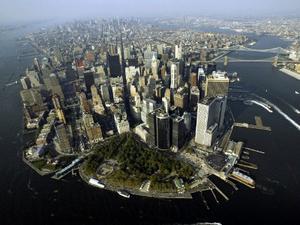Infrastructure protectionNew York State prepares for sea level rise
More than 62 percent of New York State’s population lives in marine coastal counties; sea level in the Lower Hudson Valley and Long Island is projected to rise two to five inches by the 2020s, increasing 12 to 23 inches by the end of the century (up to 55 inches by the end of the century if accelerated polar ice melt occurs); New York Harbor has already experienced an increase in sea level of more than 15 inches in the past 150 years, with harbor tide gauges showing a rise of between four and six inches since 1960

Not a large margin for error // Source: dnainfo.com
On 31 December 2010, the New York State Sea Level Rise Task Force released its final report on the impacts of sea level rise on the state’s coastlines. The report includes fourteen specific recommendations aimed to address these impacts.
The Task Force recommendations include different executive-branch and legislative actions. Most notably, the recommendations seek to discourage development in vulnerable coastal areas through specific changes to a number of state laws and regulations governing the environmental review process, protection of wetlands, prevention of coastal erosion, local planning and zoning, and handling of hazardous waste, among others.
Julia Ciardullo posts in the Columbia law School’s Climate Law Blog that the Task Force proposes, for example, the following statutory and regulatory changes:
- revisions to the State Environmental Quality Review Act and its implementing regulations to strengthen the environmental review process for actions undertaken in specified coastal risk management zones;
- updates to the state building code to address the impacts associated with sea level rise, coastal storms, and coastal flooding;
- amendments to the Real Property Law to require real estate brokers and lenders to disclose whether property is located within a coastal risk management zone;
- changes to the Coastal Erosion Hazard Areas Act to provide for penalties for violations of the Act and to allow the New York State Department of Environmental Conservation (DEC) to compel removal of unauthorized structures and/or restoration of unauthorized excavation within coastal erosion hazard areas;
- amendments to local planning and zoning laws to require consideration of sea level rise impacts when zoning waterfront areas;
- a requirement that DEC consider sea level rise when making permitting and remedial decisions for solid and hazardous waste sites; and
- the addition of the following language to the Tidal Wetlands Act: “It is declared to be the public policy of the state to preserve and protect tidal wetlands and to prevent their despoliation and destruction, giving due consideration to the occurrence of sea level rise that will result in wetlands loss and migration, and to the reasonable economic and social development of the state.”
CLB notes that the state is also encouraged to adopt sustainable adaptation planning. For example, the Task Force recommends the use of non-structural measures (such as prohibiting development in unsafe, high-risk locations, or relocating, elevating or flood proofing existing coastal infrastructure) and natural protective features (such as wetlands, dunes,
